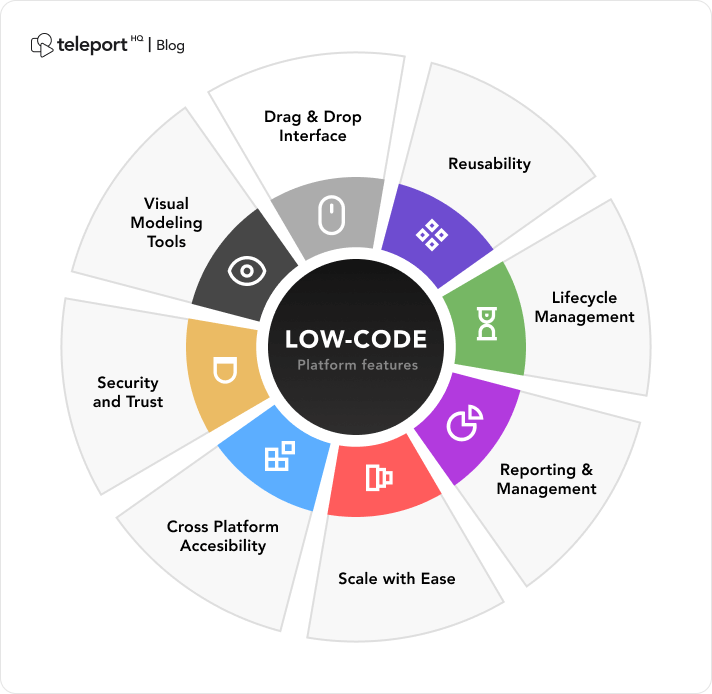Good Facts On Deciding On Low-Code Platform Info
Wiki Article
The Accessibility Of Low-Code Applications Is One Of The Main Advantages.
Due to several factors the development of low-code applications is more accessible for non-developers. They are commonly referred to as "citizens developers."
Drag-anddrop Builders: Lowcode platforms include drag-anddrop interfaces to let non-developers create visual applications without the need for codes. This lets development be more accessible to people without technical background.
WYSIWYG editors: These "What You See Is What You get" editors allow users to build interfaces and workflows that are similar to the final version. This makes it simpler to learn and use.
Simple Logic and Workflow:
Visual Workflow modeling: Users design business processes and application logic with visual flowcharts. The models are easier to use than conventional method of programming.
Pre-built Logic Components Low-code platforms have logic components that have been pre-built (e.g. conditional loops and statements) and can be easily configured which eliminates the need for complex coding.
Reusable Components & Templates
Library of Pre-built Templats: A lot of Low-Code platforms provide a collection of templates that are based off of typical application types. Non-developers will be capable of modifying the templates as needed.
Reusable Widgets and Modules Users can use reused widgets and modules, streamlining the creation process and reducing the need for in-depth technical knowledge.
Guided Development and Tutorials
Step-by-Step guide: Platforms provide tutorials and online assistance for non-developers building applications.
Interactive Tutorials Interactive tutorials are hands-on and interactive that allow users to learn by doing. This increases the confidence of users in the platform.
Integration with tools already in use
Seamless Integration: Low-code platforms are designed to seamlessly integrate with the tools and systems within business (e.g. the ERP or CRM) that permits non-developers to build applications to work within current workflows.
APIs Connectors: APIs integrate into apps to facilitate integration. This allows non-programmers, who don't have programming abilities, to connect to external services.
Collaboration Features:
Team Collaboration Features, such as real-time collaboration and shared workspaces, enable non-developers and professionals to work together effectively.
Access control based on Role: Non developers are able to be assigned certain roles, with appropriate access levels. This lets them participate in the development process without compromising security or functionality.
Automated Testing & Debugging
Low-code platforms come with tools for testing and debugging that are built in. They automate this process so it is easy for non-developers to make sure their apps run.
Error Highlighting: When issues arise the platform flags the errors and suggests solutions and guides non-developers through troubleshooting procedures.
The capacity of low-code software to allow development for those who are not developers is its main benefit. With its visual-friendly tools and experiences, low-code platforms let business owners actively participate and maintain applications. Have a look at the most popular wavemaker.com coding for blog info including azure sql databases, develop web app, cross platform app development, app modernization, azure sql, cross platform app development, develop cross platform mobile app, driver jdbc, application modernization software, push alerts and more.

Low-Code App Development Has Numerous Benefits, Particularly In The Area Of Cost-Effectiveness.
The low-code approach to application development is a cost-effective option that offers many advantages. It's a fantastic option for businesses looking to increase their budgets while delivering quality apps. Here are the major benefits:
Lower Coding Requirement: Lower Coding platforms remove the requirement to code manually and save developers time and money. Also, it means less labor cost.
We need fewer developer resources: Low-code development takes shorter time, and it is more simple. This means that less developers are needed. This can drastically reduce the need for hiring and staffing expenses.
Faster Time to Market
Accelerated Development Cycle: The visual tools for development and the pre-built components offered by low-code platforms allow for rapid development of applications, which allows companies to get their products on market faster. This could result in faster revenue generation, and improved positioning in the market.
Rapid Prototyping: Businesses can quickly develop and test prototypes, reducing the amount of time needed in the development stage and allowing for faster iterations based on feedback from users.
Low Maintenance Costs
Because of their modular architecture and common components, low-code platforms typically make it easier to maintain applications. This reduces the cost of ongoing maintenance and support.
Automated Updates - Many low-code systems are capable of managing updates and patches in a manner that's both secure and timely. This eliminates the requirement to manually intervene.
Efficient Resource Utilization:
Low-code platforms empower business users and other non-developers to be part of the process of development. This democratization allows businesses to use the skills of many employees, and lessen the dependence on high-paying programmers.
Improved utilization of IT resources IT departments will be able concentrate on strategic initiatives, instead of being bogged down in routine tasks of development. This will increase the overall efficiency and productivity.
The Scalable Pricing model
Subscription-Based Prices: Many lowcode platforms have flexible, subscription-based pricing models that grow in line with usage. This allows companies to be able to align their spending to their needs and future growth, avoiding large upfront expenses.
Pay-as-you-go Options Certain platforms offer pay-as you-go options, which ensures that businesses only pay for the resources they utilize that are advantageous for small and start-up companies with limited funds.
Reduced costs of third-party software:
Low-code platforms come with built-in integrations and functionalities, which can reduce the cost of subscriptions to software and licensing.
Pre-Built Integrations: Availability of pre-built integrations with popular platforms and services eliminates the requirement for custom development, thereby saving time and money.
More ROI
Increased Return on Investment Rapid development: By combining less expense and a shorter speed to market, companies can achieve an increased return on investment (ROI).
Improved agility. Businesses can adapt quickly to the ever-changing market conditions and customer requirements. This will allow them to stay relevant and are able to take advantage of new opportunities.
Lower Training Costs:
User-Friendly Interfaces: The intuitive, user-friendly interfaces of low-code platforms reduce the learning curve of new users, and reduce the need for lengthy training programs.
Accessible Resources that are accessible. Many low-code platforms provide comprehensive training material including tutorials, training, and community support. They make it less necessary for formal education, which can be costly.
Collaboration streamlined:
Enhanced Collaboration Tools : The collaboration tools built-in to the software facilitate communication and coordination among team members. This results in a more efficient project development and lower overhead.
Unified Development Environment : A unified environment streamlines workflows and cuts down on the expenses associated with managing various tools and platforms.
Low-code development is cost-effective since it lowers maintenance and development costs. It also reduces time to market and optimizes utilization of resources. Pricing models are flexible. The combination of these factors can provide businesses substantial financial benefits which makes Low-code a desirable option for companies seeking to make the most of their budgets for development, while still achieving robust and scalable applications. Read the best wavemaker.com coding for website recommendations including cloud software applications, app dev platform, application modernisation, app platforms, develop web application, cross platform mobile dev, app development platform, application modernization software, ms azure sql, cross platform app development and more.

Low-Code Applications Offer Benefits For Collaboration And Workflow
The low-code method of developing applications offers a variety of advantages in regards to workflow and collaboration, which makes it an ideal choice for companies seeking to increase team efficiency and streamline their development processes. Here are some key advantages.
Unified Development Environment Low-code platform provides one unified environment which allows all the members of the team including analysts, developers design, stakeholders, and more, can efficiently collaborate. This helps reduce the number of silos and enhances communication.
Visual Development Tools Low-code platforms are simple to use and feature an interface that allows drag-and-drop. This allows non-technical members of the team to take part in the process of development, which ensures that business requirements are captured in a precise manner.
Communication Enhancement
Real-Time Collaborative Features: Many platforms that use low-code offer real-time collaborative capabilities, which include simultaneous editing, comments, and instant feedback. These tools facilitate the communication process and decrease time spent discussing back and forth.
Shared Workspaces: Teams may work together in shared workspaces in which they can review, edit, and discuss aspects of projects, ensuring that everyone is on the same page and working towards common goals.
Streamlined Workflow management:
Built-In Tools for Project Management: Platforms that are low-code usually include integrated project management tools that aid teams in planning, track, and manage their development projects. This includes assignment of tasks, progress tracking, deadline management and much more.
Workflow Automation: Automation of routine tasks and workflows decreases manual effort and errors, allowing teams to focus on more strategic activities and improving overall efficiency.
Faster Iteration Cycles:
Rapid prototyping. Low-code platform enables rapid prototyping. This allows feedback to be quickly integrated into the application as well as rapid improvement.
Agile Development Support: Support for agile methodologies lets teams work in sprints, continuously offering small increments of functionality, making it easier to respond to changing requirements.
Accessibility for non-Developers
Citizen development: Low-code platforms enable business users to modify and create applications without extensive programming knowledge. This frees IT and development teams of the burden and allows quicker responses to the business demands.
Training and Onboarding. The intuitive interfaces of the tools for training allow new members to get acquainted with the system and this enhances teamwork.
Centralized documentation and knowledge sharing:
Integrated documentation Low-code features typically let you create and manage documents within the platform. The entire project's information will be centralized and easily accessible.
Knowledge Repositories: Teams can build and keep knowledge repositories, which include best practices, templates and reusable components, facilitating sharing of knowledge and reducing the duplicate work.
Consistency Standardization, Consistency and Standards:
Standardized components: Using pre-built, standard components guarantees consistency across applications, making it simpler for teams to comprehend and collaborate on various aspects of a project.
Governance and Compliance: Integrated into governance frameworks that ensure that every development is in line with the organization's standards and requirements of the regulatory environment, reducing non-compliance risks and ensuring applications meet the highest quality standards.
Feedback loops:
Integrated Feedback Platforms with Low-Code provide users with feedback mechanisms integrated into them that enable them to provide easy feedback on applications. The feedback is used in the development process.
Continuous Improvement: The capability to rapidly iterate on and deploy modifications as a result of feedback ensures the continuous improvement of the applications. They are closely aligned with users' needs and business goals.
Visualization, Reporting and Analysis:
Real-Time Analytics: Built-in analytics and reporting tools give real-time insight into the performance of your project, its progress, and user interactions, enabling data-driven decision-making.
Visual Workflow Mapping: Visual tools to map workflows can be used by teams to optimize workflows. This allows them to identify bottlenecks and areas of improvement.
Low-code app development offers many benefits for collaboration and workflow. This includes the ability to bring teams from different backgrounds into one space, simplify communication and streamline certain processes. This creates a more flexible, collaborative and efficient environment for development, which ultimately leads to better quality applications and better alignment of business goals.
